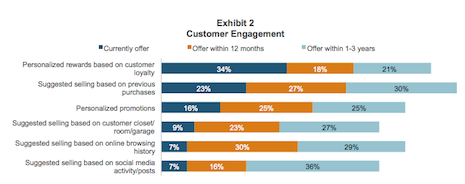Luxury retailers who are continuing to put stock in the bricks-and-mortar space need to implement some form of customer identification technology that recognizes individuals right away instead of waiting until checkout.
Now that online shopping has become so prevalent, consumers are no longer propelled by necessity to visit bricks-and-mortar locations. Retailers in the physical space need to make sure they are offering an experience that entices consumers to come in to the store, according to Boston Retail Partners.
"With the advent of mobile technology enabling instant access to products, information plus the ability to immediately purchase an item, the act of shopping has changed," said Jeffrey Neville, vice president at BRP. "Consumers no longer ‘need’ to go shopping – if a consumer wants an item she can pull out her smartphone, click a button, and the item will be at her door within a day or two.
"The advent of online shopping has made us all constant consumers," he said. "Because of this constant ability to shop and easily research the lowest price, retailers – especially those with brick and mortar locations – need to further differentiate themselves to entice customers into the store.
"Providing a more personalized experience and offering value-add services can help even small retailers differentiate and compete successfully against companies like Amazon. The best and most powerful way to succeed is through a broad portfolio of personalization techniques."
Personalization in retail
While about half of retailers that were a part of BRP’s "Digital Commerce Survey" said they would likely be implementing some form of customer recognition technology within two years, currently most bricks-and-mortar stores cannot identify a customer until checkout.
The point of checkout is too late in identifying a customer and retailers are missing on ideal marketing moments that could take place if they knew the individual as soon as they walked in the door.
Through the use of beacons, mobile devices and other technology, retailers should be able to recognize a customer when he or she walks through the door. Valuable details regarding spending habits and interests can be tapped to tailor a shopping experience to their specific needs.

Chart courtesy of BRP
Personalization is key in connecting with the digital-savvy consumer of today. The personalization of online shopping can be, and needs to be, recreated in stores.
About 40 percent of retailers are considering personalization improvements as a top priority in digital strategy.
Twenty-two percent of retailers have introduced a system that will take environmental factors into context, but unfortunately most of these platforms need improvement.
Customer personalization in retail is still greatly rooted in rewards, with 34 percent of retailer claiming that is how they implement personalization. A rewards program is the top way in which retailers introduce personalization.

Chart courtesy of BRP
Retailers are becoming more interested in suggested selling based off past purchases, with half of respondents planning to do so in the next year.
Additional insight
Having one-to-one client interactions online can translate directly to bricks-and-mortar spending, according to new data from Salesfloor.
The retail platform, which counts Stuart Weitzman, Bloomingdale’s and Saks Fifth Avenue among its clients, conducted a controlled experiment to attribute in-store conversions to online engagement. Salesfloor found that for every $100 in online conversions, up to $68 of sales were driven in-store (see more).
As data collection technologies progress, retailers are finding more reason to expand their analytics abilities, something in which luxury retailers can benefit.
According to another report from Boston Retail Partners, 44 percent of retailers think that analytics is a major priority in the future. Additionally, more than 82 percent identified the need to improve their planning systems to act on data analytics as something that they need to focus on in the future (see more).
"The first step to engage with customers on a personal level in the store is to find a way to identify the customer as they enter the store – via smartphone, beacon or other technology," Mr. Neville said. "This offers retailers the chance to personalize the customer’s shopping experience.
"Half of the retailers surveyed in the Digital Commerce Survey plan to utilize customer-identifying technology in the store within two years," he said. "However, today, in most cases, the customer is not identified until the point of checkout.
"This is too late to empower the associate to personalize the shopping experience. Customer identification needs to happen when the customer enters the store for personalization to be successful."
{"ct":"g16ZC8DIuuphtcCXGRzkaYagEd8jFpS51uIAsKtKfVsfu8kPAHp\/3VclLxDR4iCmA+QVF5F1BV85LMnBGBL8oMK3l8REP1PZGRXRI1g3vJZaFlpJ6DMvUDMGKmCZBcTeLx9rn+4DOrHkjc4+Zn9B\/q9UzXwFLHsZf7Pstk\/rXfKnaOuOJN17AKQD8heuDxXiXTE0KGCO\/AdzOoDwUTRMV7qfvNMItSNNXTVYTgZem6lXOlB7uw3nTlcpCcYuEWM4E7IMLA1\/NCrdqm0mJ+xufx7lVGIlp7VelScLGgdzYrV63zIq3nYmF0U82PeRM\/Ggg1QQAeAdiI1t6Css1mPgEAOLpeBRafUhvGQc49YZunkho9Mh0A8CLWdqZ6ZuHNiuFZSUykAkcb8QYAmLCGPF79yP29r0dWAOqlrypjS8UEDBfwz0N4qKr8Xb2mVCxRRb7sAjlhHkqSBf1Ra9TiQ3Gfi7hxrla6+\/1qgzMm7DTwi1WYtAR4uSNa2ZZsbXhTnBuStgPXYgwNysFneICtAZL8vWDnC6VZSNjN3tNVTE9uHbXyiAquvmAgVbxAgAB\/6\/9vTy4zUgM5aSwTrGwiNr\/8YQzyu1IahHKeFVd2QqFURR+2OYL1dcdpCjxieJi6fqRLhBzDO9A+MKa0ScwQucDGd3OsnBCjsSrG9le95vkpNtqu2A8YQD0z3gdf+ZsrmTOQxjEjR4\/cKdqf4SFrRVfxFswx2UCcz1FKvhADrmn\/JGz34MDVNBAPg8JnFW3fptY4qAlm5lvTZtxeiJkt6GDEG4qR7CLYqdbgbD4DwGthGjVK93ejSyWvtP8DRwjFKJ3tlLv+fZ\/PVZ+K6fEDeIyarUt5o4yr1aAAkF5lc24weD4YN0ewR+pvmzWtNXQkDCzRw2EcMqxdIhpOQH5S2sMQbQ\/DueJdswAUbtTuz+l\/wvEHslwM010mB0g0QE9i9LTzFgcb7LwXpjs279zKf2C\/4f2NtJG98cRnBPK8H9F1uS8\/nrZzf++D8GER0w+DaU14XvZg4ChxKWuVAZJ3zqi6TSofQ0McXfNwc0qjcF0Tm9Z0go9w7qrfbdHAW1R8qwV4dJWYcf8jtmBokVQhdm4nVK1rwBuvqoE5i+NerFbSSITOqGj466crQMHgmzeKTbjrkeln6UPNsbe+SR0StcqxyM3sSR5ovcWxw3hDVAFug0QX5vqtKAOirvesv4Hq150eaUAMQNluboBPiIHhL9rasPu2RxNBeZmBuIiiZylv3VRvs8UwTkpR3bbcAARk2a7KBSe0rQLlERzTd+vzJF6CpRngaAwudFAOgQzzJb0Tu\/X7t1TWVSlV94HOayGnbcEAciIxpNHoFIagEiOFjEhFemEkSsPmJJcTUwXKs99tC5K4oD2NGiwj9nLzjkdhHIjE7gevTFOVNpFxVKrcRSnDDLr96mDNWxoH7EdKiUCV0Fav1LcYbqbZo\/ejtqAtn3TZcfbT\/q6x0ZIqw54L5LfDp4TWhy45TAL3m7tqqyLnyBmfMBoZLCk1RPMrqXJ9AoyDkUYNw4ybqEQZcIkhnJuUVDACkIYOOX2Z4xmj5aJZfB0vzsf9BH67HixJ3CRRFTvNPCWsUVoj2x8z6uw8DKN0UP3fq4LH4vBwuNraVkXc4TBwSzAeH7MD6pP7XFisBh+tkuboeVy\/iv9qLikTpPpCVlH6s9qI7Me2QqT3TZSgMFBGAYt+n1x638iK2Xvzd1gtRaikoPOJQSuK8Omx47vRrsnlMTjDLQlNPbUAu39aQzNVp2StuC2nkt5NWBhYS5wnBhPLmvV1SGmKOtQihd3o6xQ9xJPfZ1OTC1xLYh9noqL35I2I8bTZOyDTuEnfDrjqLAxw91SqEQwid5KCZ73ekEKtIddVRjNjFBsq9Zv2J+y2mgByF3nr7MME6Y+vBSIsZQMC+40S80SeZ4q1CxEO0oRd9zSNvMD3Ox95V\/N3tg4OcUfKp0avoAqhJRuyfkvz9ivYFVyJ7dPrVOyJTUb\/jXd8Dyh23kjLsX1XzZRJNhLo6t9zUshnq9oUEj4kMillrRLhCVRs1Xwe6IB\/YT2pNLYChcDQmj7TV6bG843nck9tUCCJlujxT2k+ZUqmLd+DbH2aSxmldZ3Ixj4vO84kDFwbtUMk1OjQ5Z6cCu\/K4SLRdnFQzs4mBKllsDDFIOdF05K+VaB8qOJqGlxcLu97Yu1PG1A4tYUMsl0Uun2fskTOsJNgy9I4G9naWy3Ij2L45IJPPAxszwwY0FEEFCLoa6aRm097fuVIzv1Cfb4HGDAN2nlQ7NzqssLEgqDs5UbJf71iTb1ol3g9GghIqgrCyG1rTI8iI7uIdCRjJKryRPnIeTr\/lBwlZXY14wFKx\/MCC40QxaHFKxJJTL+Z5tZjPoAJ8t\/T3wQC5yHDiGEVmXBypXrASxznmmvMsmiGCxyaJYprKHJ3V\/wCoRXUx7x6en+vZAZDZmHZquO\/G5brdPZT4JZyjM0b\/WFxdn+dw9PNgzQYLWcJ4ZcAKoBv1f3AceRUvctKsu33T58OdMu8cnRMDltdQBC8BTjjlpfmgqIWthkQAFvhIieHyHcr8lqbqFvl3XyBcX\/J8u9VdXeupXdj8RUr7AdhAD1bmtB9f\/eqtRUziFYA4B5tRmpq2nAdLU8uHxZ7ZC82bBHGGaCawewphFj6MihyfkuE29S\/+z1wxXxwSKEXYIdxS96mnUlBRPlWGdFI6hce5po0UEPx65TOynxOvqMeMI7zA8lnQREU\/9d2qgP89dMH4a1JPLuaLxXg2SuMp3f1dA9j7DMGPCi33exSaQJQTWrPiQauKDukwVAKXwcIxoPKN9MH4MdcC6uJKorZcVQpOgEBv3o8pEWjDaQ98myEPQB5X5qRdd3KOdOVuY\/pgRhBOHEDTyWppI7B02W+wBdM06U42VtmY7B76fwc8K6ffuTVxNr2Y5ULbjWZh7+cGgWN2zMwBqcl5P0lXEH3zJTSD74FlYPNsYuh3sj6s1ySMrAIf7nPmDMmfkCLptQwKGzGXmkMyFOxH6AN6mPJAkoVDiug8tAMzMCzjYUliHFTsVutriA0c3YvmHQ9z4ynk1AqqEriwXWReCRh8pZ2Ao\/E\/\/g38FWnn8\/MPLeCQCakSh3EtEiSBBmQgPMjahUSAiZnlNz4J5uCvy37jG0z1Sod5Q\/zyA5e9DL\/Y+XakfIhdneJvrsoDc95aJZe2ZRloTKu45U6DPp+I2qy0O2lKaZEQUiOVoIvc6QNDNRn7dOTsrr4quYj44Gu47Ggitnyrgckr4IsidoObpupAHTyay0QmVTYKNJqRm\/qajJrD9s1XVPXit7EpSSqrRXdBm06+MB1\/rx2LC83xIbsZbJh964scnQ3U6bzh\/C4mlwtgwWFmJ85Ow5vk+6j4h8peN7SU5gAL7cRAnbBaQAj6ibIE+rMkVRoCIYWgLqwBrbts+m4XnJwE08uFfGOgbECCyx+sSY94rQ9Qiy4sqHWoaR4SpJauvgEq5CX2yPySyQTDjCdqnlQSG3tAn5rKRJaz9+y9BFBKeGe9cAMhP4Hdvf0Fb\/fIuTM0Ez54vbnqIkMB0R6ZiFgTCvdIpCaiHd6h7z7pSlpX4rzxGjMAZIqDjd\/Cz7el\/8ES\/uQ5YxHJ4IZFA7Kct\/7sG\/RchLm6I2ow2PT50EVErk2UYdtSB13B13tCYTsHzedhUe9XMZ7tqXF4RNgVpZaE7CU17uMD\/nt1xd4IsRDfQedFhE2BYzaHNH91\/pY8Wk\/+BnJliQ4sUQfif3m\/gF+yzeWNsD4FvCWpg5IlwiesoOTYj9+IISTi0HHZG0xxDfiC2pqjQIGXN3TiyZZELlLavEJF7tYncvH1uUeQOlOeYQ\/5zRfUnFHdBNjLASmgf9xSA0LRR9HhOYJjleuvhCU\/evC\/6zgogQ+RYMgLXTUMifK1bPoPRsHB8REByysh22CiHDGLrBiT\/l7OUnwwxDTJQa2Nan9lx7Q3sn4iYlA850+T3kZsfpxjsTyLNTgvBvduTIRBEQlbgk4PpfddtC0DMchlkUt\/SQ+FIs9TaKXETFGmQ5z63ZlQFrJ6dCj5rRgzTnoIjKvm2qYg9cToVXNli8ktjlNOapVYWO8s2s0OgedFrrK9w2mDJd1AsGFDXVfLs0WXC5nQhsC6PHObzKnO+gBwJqcB6gmynk92IcPAG3905JkQp0jhV4BHT4MVDdYlLezIRoLzR2AFZ8bk\/DV+giSTtqK3KpHdRkU68XVEE9vOo9WP5nwsG8aQ7O8RKIey5MaE5FCKGTQeVdcyEgMHTohcTGgwACUDxSVx9PSDIpHQyC1Z6DXhuZ69a9mZwpKQdfpl6g3fYlnEbkT4ruC1Go1Vt399GI2koLt23Y3j3mMRh8lcLeGxj9s8UDA8xxIuCdXbP\/dli5zNAZjUd8XUm14SZdas2lzDQeqVEpJ4uYIL+zV\/Cuu\/kYCNWVONEcxDHfAnCsBIKGniaLNUlINzz6ypTpFfyr33U5cIOvvP7IYgSXY8J6XZpTF3j\/qK3mU636ieDTP58mLABfryfbwqGZKzhSXkIgqf6ZSNLXjyt80hWp9gntAVK324g9aUqmR48bILsOi9cEsMTy1J\/EIRfr1Tfi8u8pXZnuMHtiY1BEr4BkPZPOVeAYUGrmPXgew4Biu5dwWofvJgYDgfa8egliOeOlZEWgopWWTRQR8MCJ0uNnEBjLyFA750Zf1\/uVSHFjz2dImLqZyWHdaHZT1QwHpSWDpPSxd\/RxituKoHrOwrmiU0CnG8L\/8HU4NCGr3cl5wKdW0N7CTZv0S04LvDUMVdmKX2t+iqWD8Jo10n5UrZG2Z9M0YyZEdZWH4aDrz9jR4FFmcKjStVeKWgL0J7xHNt\/4EOpe9Jjjsg0LCJk\/WGYJ1qJPXx5IrGdvWJTtAFzYCIdstAqRROvDoKz35kJsseUgI7L3KWGXgP7Q3AUNmmNz62uyMhxVKMMqNApG+HtVlMcNGYoVsgRGYmhUn\/JzRzH7il4D5Q74rKN5TKlQvJAsJ3VZ0KV7gw9T8kGFU20a7+IcAZulJH2s1aC3u+ztx37rxv2GxD+7x15zYUbbaAKI5h93F8dOAQj3+6QqcH4EbZNcm2\/oivGge\/e4KgJ7JfmDOkBaGEY2io4NzphEyzBkrGOqpuJ0\/ZcHPE1t9siDgzTFVIcFCCcpOoJD7wBzEGgEmtMm0\/FD\/zdo7V+Tv9uxkI2eI5GpsQiJ1YGbjbly\/NX7FekZknML\/zJoGF5ijFDAAEJ3jPMX+4g162R0yIkO4RsHxGMbsfEz0hB6QvzDj0BwOHe7xdNgPNuLIT1aIO2tTHE3GUX0wyUMfUi0Vxqdi\/niSM4zOSRgs\/RrOZx2h7xgJG7xY8wicrxzlnr7sipC4OVJmJvybxTcZzB+s9Ma1dwbUjMksLufo2dqTbVVXfdvUqsrV6pPIJHOnf0rtip3P9JbAJH3PawZYWt9AXzze5\/CX8Hv3bBF\/1ETS5TYVOhy9r+wiP3qPvKvD9VfBubuLAknATCwCBb0bYntcAmEBmgG+w17GBSbmZzrFpKQdpilY5KCygPWtkoBRMBdx753eVINcKrxkLW4T1+CddHlihXOLsDXfkXKK1c9H6DHz0jI2sbXxyxyUuSlNp8SHrT5euDhmI5b0S6o3Oe9zP\/ZJrAQZWjOujCq0CgPCwTvhLH0Ap1imSA3EA+V8tJ82FC3AN7LokOPspQ8Vh10mRZNxYkd5F9itFTf5KxHudxIrUEXbQjQ+fih1zRKP3M2MeZy7Wps9nMfu62JTslAYgdajPj9dEJEqu666zo5dhSo0J66\/SFikvsxKmDOyvFN6QfHV5tmE1i6rvBjR0p7pCcr8QZc9u7W4+Lrp6Flb\/9P40ui71yAzlvm18UwcBAq9lW19xuToP82O6c69yRaDhU9s2eJ00uTHS6L0F2GsX0tzKkRUFVmujFz5r0xUY7DhattpCn27kJAFAjEtNWT68whQva7Skz4trvzSLc1j219NUgZzGUZzP2p4WennUJJuG1SErErZJvfZjTGgSrHQo0TXG+D71liW8maEeWmE\/qrdH7xI3sloqFY2L8oB75LUk1rz6cUpm4Ecg5MtmARpN3rQSnRbxudY\/dLTN86kslj9ttinYgyV2gL1AFnxzyQCM8xu6mSTD0z3fj4QpZdGrwlR1CPyGyBgHZ89\/YwuxSqBYSdLrscReP70v36igSU5ANCx6i1m6RqLQxnpFSqN4sLzM6CoSGO+pg+Z\/SDolour0pa1K1vqdOOCojAnX01mg3OYeVYoyP0HaAV9yEeJwj2w\/AVbJ\/tioR5mie8GR8isfcG\/mzUCZqDC9iLCdw9gk4jL6hmc8Wv+5Cq1i714gxWINWf0HKQ+S9e3HMsH4C5Crh10aK8\/jtvWp92Q6favi3j1JEkLd\/PtTXoDFvPqX6NgGCoM0EUXRGzqQWnD760L5Vx9\/Ga+loDjxJjxgCX+s0mQxOaT\/unrRE+h5CBi\/nIPcC5ILjpsyYpW0VVE681Q5uPTdi1OfBw\/7z96KYQBXbKJIheVIfyetWs\/LVn1Ti0FhxMIFYAuvr+vmmgy9PPnTDRDFbtP8gwL2N5BNtau3TbQca9lB7Pnd4Dg3QEV7QMFUEfJPY5mBiKNcXZxOG+9q\/CdIQz25Vo7eb+AyXMkdFCv3vghR4+Yi5YCz\/EP\/MbPeAE\/2Cf+sFamrSFGjR8zb0S613N3DwZpd1\/wDeQq+MT3AcDsxIu0gBetoGNVDNgBloE\/d9XZKaGPydZouGmGuCUpCW1uSZu3lqCoqBz14KBJgUOXX0zr1Vmn1bgfVROFFR4zxz38m8m4eC0dmRqutesL2NlmpaQMSggTGBDCvTWFyOuzwfLufjsOOO1VVW469NQmr7cYKqdASsMV3zfoWy2hJStdw7t6xkspvpHUVguEr097BoY8Uv3aEabTu1q5wObIPX0gGV+qd3lP6xaf\/MwIhKOskkmQzlptyCBrjoArRrYw6dY9IxAI\/NsW4xHqDs6wDbIS3bF8r5dUwHgMCZ\/Iy70QfDoRfPDk9tFrLCuWRVpz756MnIBXcRNbHu1BwSAY6ukIdYBWwSE\/n1zDxSHxgWeiyc9W17Jv7ixyf9hWB7idmvpNX5RME07EbAMecT8SM0wUJd77dEcoSRWoU\/QLsl7m+UrYvjNutBhrWqM2cukxXzr4J3DShgd\/12e3bBdf5Yul0gYGKT\/4hYwqwWZGH5xrxG9RR+mrh3V07piJvFZrR+eMfrCb\/gLMZjptnyFRdybSLos9vaMy8FxUvAWX7749JI20\/BWODng3VyEE5BY\/5\/WIfhMwKUyIXdxCO\/5fL6QREIwvbw573zztDUWpjksrCBFKU6\/VZ\/fTVjub+alRsOvYFG6hWj0mRbfp5oazxvGnextejmy0Vqy\/USse0kxR+RhI3vVx116GAAePkiB6gjNu9sF3YBEhp+tDt9swqJQv2p7VeeTQuQZdobJF3HGpnNifYWnG7Mrbolq5JX9fC1uVDLOkJRKJAZWFTsDBpnWfXHCFh9FlATk+82hfv9cpFWlC\/lgd\/a98gr+mJ4rBd6HLvfTInoWe6hFf3NBpiuNYfb+syEJwN\/dOxmBDh\/dIDy9OYUeQU8567ROfhE4TdDrEFuAHkPa61U9SaWFMV7RjUdyMMpqiriuLWSNJQjT6gz0yDLLK+PbRKcgSr2PdAesnpXQdQ0LAIjcpA19Ke9QNWb\/OsEG7tAiKETy\/I+kJt+arXcAMz+IjQv5EIewReH7ncrtCqXIFofY0uzSio0iW3IR7DaRAuO32X5LFocQdFtVV3m+VmqRADgOh9Pzr0UxmB2Ws2WB4bC1Bq\/VH1qrlE0nhfcCZdZrM+iM9kBOfyveXUmQIekb+Ir2K4CRaeAFYSG9sqy8H4s9MTgS49TRPrdkCfCa5KW5sm0hWE0xTFEUPMHtOOvUFz1hMQ9\/Lrw2pOBv4AQsY1t7zXR4iNHyVX8xjDKeCBgG2O6FedDEw\/LjD0zu0d9hB3KBIh3NlEX6bb5X64N9DPoho+cIpCzoG3JL8y8+8nVbwjlfz8RKZAVGH3upUtVaABobh4c6iZtFMzoU0iIhvzmAHtszgnvvM6Lo6UfP\/MaQwGu3MRa4loBXHoAc43qyteE+UzcF0\/Cj+qR76gUa4FwpdABUdh3z0f8Mq3WFt4jxPiGtu1eTgZT+AGgoDNzd4OCVCym6sG7ClYPWxHArp+7y\/xiGp08zlLRspBeDlv5xqvA\/1o7irtvgpkyvcooIBTiYn2yEbXlZbKt188TeaLL3V\/pvkVSoppSMyem3sFxnugWMbLc99EvX\/erlEzAm\/J4PlHHyXuBKdFuda14Y9mygXacBNulEbB7SLOyVSE4yQO\/Kn\/vL80kkEhFGAZTOXom","iv":"d8ea5ada97235e37afe9ef62a25ab709","s":"369bb795f667dca7"}

 Image courtesy of Neiman Marcus
Image courtesy of Neiman Marcus